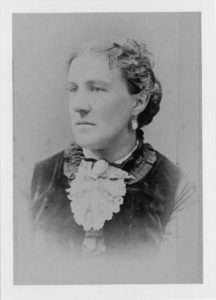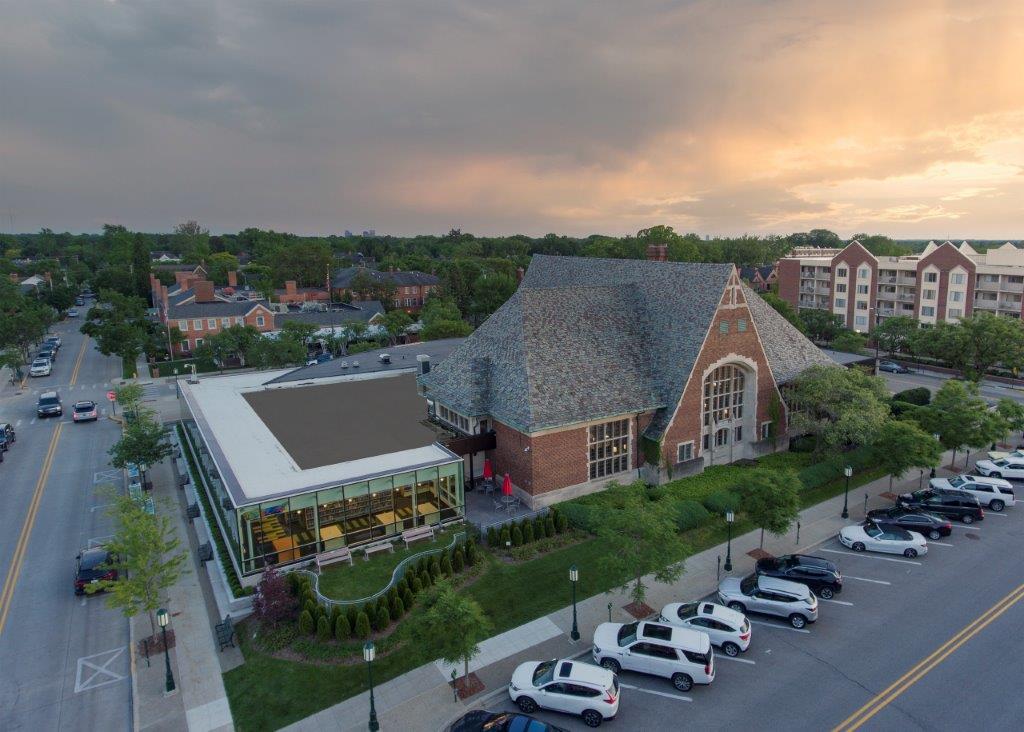
History
Library history in Birmingham begins with Martha Baldwin. In 1869 Miss Baldwin and nineteen others formed a literary club, the Library Association, with 48 volumes. In 1871 the Library Association purchased the First Methodist Church on the northwest corner of Bates and Merrill Streets and by 1879 they had 724 books. In 1890 the newly named Ladies Literary Association ran the library and in 1893 the Association began a fund-raising drive for a new building. On Dec 1, 1895, the new Library Hall on Troy Street (East Maple) was opened.
By 1905 there were 2,000 books in the library, with a $1 fee for the residents of the Village of Birmingham to read them. During the next decade Martha Baldwin worked tirelessly to create a public Library Board and to fund a new building for the expanding needs of the citizens of Birmingham, efforts that were both realized. The Library was established by the Village Council after approval by the voters. Election records for the Charter Election of March 11, 1907 states “The whole number of votes given for and against the proposition to raise a ½ mill tax on the assessed valuation for Free Public Library, subject to the approval of the village council.”
Location - View Map
300 W. Merrill St.
Birmingham, MI 48009
Library Hours
Monday–Thursday: 9:30 a.m. to 9:00 p.m.
Friday & Saturday: 9:30 a.m. to 5:30 p.m.
Sunday: 12:00 p.m. to 5:00 p.m.
Upcoming Closures
June 19: Closed
July 4-6: Closed
She died on Memorial Day, 1913. On July 8, 1913, the Village Board unanimously voted the following resolution: “That the public library of Birmingham be named the “Baldwin Memorial Library” in honor of Miss Martha Baldwin who has always been very active in its interests, and whose liberal gift made it possible to have an institution in our beautiful village.”
The part of the building now known as the Grand Hall was opened to the public on December 19, 1927. In October 1959 the addition of the Youth Dept. was made on the east side of the building. In 1983 the library in its present form, with its entrance on Merrill St., was opened.
In 1869 there were 48 books in a literary group. There are now over 120,000 books in the library, along with compact discs, DVDs, Blu-Rays, magazines, educational toys, newspapers, audiobooks, electronic databases, downloadable books, magazines, audio and video, and an online catalog.
About Martha Baldwin

Martha Baldwin was born August 22, 1840 in Birmingham, Michigan – died Memorial Day 1913. She was the only child of Edwin and Aurilla Baldwin. Edwin’s father, Ezra, had moved to the area in 1817 from Vermont. Edwin was the only one of his siblings to settle in the area. He was 15 at the time. He married Aurilla when she was 19 and he was 34. During their marriage of 52 years, they were dedicated readers and proponents of education developing the path that formed the philosophies for their remarkable daughter.
While Martha Baldwin was a dutiful and a loving daughter, she never married. She chose a teaching career, which at that time forbade marriage. However, she was and continues to be a role model for countless numbers of young women whose opportunities were broadened due to her selfless work. She paid special attention to Charles Shain, the young son of her best friend, and financed his formal education and influenced his attitudes toward community service. Shain in his adult life was also to be one of Birmingham’s most influential residents. In fact, Shain Park in the heart of downtown Birmingham is named for her protégée. As she worked tirelessly in a male dominated society to advance the causes near and dear to her heart, she was able to rely on the support of Shain when the other men in the community considered her causes too radical.
As a young person, Martha attended High School in Birmingham and Kalamazoo College. She lived with friends in town and return to her family farm on the weekends.
When she graduated from the Academy in 1858, her parents thought she was too young to leave home. But she wanted to teach and eventually started her own school in Lexington. The school grew to 18 students, but Martha was very homesick and returned home in February of 1859. This time is recounted in her original diaries, which are on display in the Baldwin Library.
At that time her father gave up the farm and moved the family into Birmingham proper onto land located at Maple and Chester.
Martha longed to attend college, which was beyond the financial means of her family at that time. Finally in September 1860 she left for Kalamazoo College. However, her formal education ended after one year there because her father faced financial troubles. Martha moved home and started her teaching career in earnest.
She had a distinguished career teaching school in Franklin, Birmingham, and eventually Detroit. At one point she was principal of a school with 899 students, more than the entire population of Birmingham. She did garner some critical remarks due to her liberal philosophies. She retired at age 58, partly because of a new regulation from the Detroit Board of Education that all teachers must live in the district. She was too dedicated to social projects in Birmingham to leave.
While a teacher she helped establish the Teacher’s Mutual Aid Association, the Detroit Principal’s Association, and helped write the Detroit Teacher’s Pension Law. Until that time, teachers had received no benefits of any type.
While considered controversial and a troublemaker by many, she was an influential and notable personality in Birmingham and the instigator of many organizations and projects to influence the quality of life. Even a partial list of her achievements is impressive:
- Founded the Village Improvement Society to keep the streets clean and to plant flowers along the highway.
- Helped pass an ordinance that made it unlawful to tie a horse to a shade tree as it might harm the bark.
- Was instrumental in getting the anti-spit ordinance passed.
- Was responsible for the maple trees being planted along Maple Road formerly known as Mill Street, seats at the streetcar stops, wastebaskets on public street corners, public drinking fountains, and the first kerosene street light, and the waiting room at the Grand Trunk Station.
- Worked to get paved sidewalks so women’s skirts would not get so dirty.
- Was one of the first to advocate for a water works system for the village, personally paying a well-digger to show the advantages of an artesian system.
- Was the first resident to apply for a permit to connect to city water.
- Launched personal anti-litter campaigns, driving around in her surrey and having children pick up litter and deposit it in the baskets she carried with her.
- Established The Ladies’ Greenwood Cemetery Association when the cemetery had fallen into disrepair.
- Established the Village Improvement Society in 1884 to clean up and beautify Birmingham. Had a group of 22 children that she used to help clean up and circulate petitions and proposals. These included the installation of street lamps, purchase of an old gravel pit and establishment of a park on the property at Maple and Southfield Road, building and landscaping the new train depot.
- Formed the Committee to Study Conditions at the Oakland County Jail.
- Organized drives to provide reading material to the residents of the County Poor House.
- Spoke at the schools every Arbor Day and handed out seedlings to the children to plant at home.
- Active in the struggle for Women’s Suffrage and the National Federation of Women’s Clubs. Seven time served as representative to the National Equal Rights Convention.
- Member of Women’s Press Club and the Twentieth Century Club
- Wrote a pamphlet on “How to Form a Village Improvement Society”. It included this quote, which summarizes much of her attitude toward her good-works. “Beautifying little places helps make the complete world beautiful.”
Additionally, Martha or Mattie as her friends knew her, was the first woman in Birmingham to hold public office. She was elected to the Birmingham School Board and eventually became its president.
The Baldwin Library continues to revere her for her role in the formation of public library service in Birmingham. On November 1, 1869, she organized the first meeting of the Ladies’ Library Society of Birmingham in which 48 books were purchased and thus the library began. As was true of many communities at that time, there were only a few men involved in the beginning of the Library Association. As the library branched out to work on many cultural projects, it ultimately was run entirely by women. The first Library Hall was in old Methodist Church at Merrill and Bates 1881-1895. Later it moved to a municipal building at Woodward and Maple from 1895 to 1927. Martha Baldwin led the fundraising drive for this by selling bricks for $1 each. When the building was ready to be constructed the village was still short of funds. Martha Baldwin provided $2500 for the mortgage. The Municipal Building, which housed the Library, the Village and Township Offices, the Volunteer Fire Department, the Police Department, and a 400-seat auditorium, was used for 30 years.
In 1907 the Library Association offered its $5000 in assets (including 3200 books and pamphlets) to Birmingham for a public library on the condition that a ¼ mill tax for the library would be also supported by voters. Another condition was that if the village failed to maintain the library properly, it would go to the Board of Regents of the University of Michigan. It took two elections to eventually have the library become public and although Martha Baldwin was on the first appointed board, she was defeated for election when her term expired. She did get back on the Board and served until her death in 1913. The millage debate was very rancorous and even after the millage passed, it was challenged by some residents in court. The election results were upheld.
One difficulty with the campaign to establish a Free Library was that Martha could not separate her speeches about women’s suffrage from her speeches supporting the library and consequently alienated much of the male population at a time when women could not yet vote.
Upon her death in 1913, the Birmingham Community celebrated her life in a number of important ways. When she died all local business closed for her funeral. Two hundred school children were let out of school to process with bouquets of flowers The community as a whole attended her funeral and the village board voted to rename the library after Martha Baldwin. Miss Baldwin left $25000 in her will toward the construction of Baldwin High School, with instructions for it to have an auditorium and free public baths for both men and women. She stipulated that the school needed to be completed within ten years, which Birmingham did! Additionally she left $1000 for the Cemetery Perpetual Care Fund and two parcel of land to be used for parks and she left 13 ½ acres of wooded ravine to the city on the condition that it be used a park. If the village did not do this, the property would revert to the estate and be sold. She was buried in Greenwood Cemetery with the simple granite headstone she had requested saying that she preferred a “monument of good work to one of marble.”
Today we honor and hold Martha Baldwin in the highest regard for her contributions to Birmingham and Oakland County. That great legacy certainly includes the numerous cultural and educational institutions that she influenced but also for her legacy of spirit and determinism that women can and should have a role in the development of their communities. She often came under male criticism for her forthrightness and doggedness to improve the quality of life in Birmingham. The words of her peers used to describe her include: “indomitable will-power, perseverance with a warm sense of humor”; “strong-willed, fiercely independent, and committed to her work”; “practical visionary”; “efficient organizer.” What a splendid list of faults!
Looking for more? You can find Women’s Work: The Story of Martha Baldwin or Martha Baldwin’s Diary online.
Bibliography
A Narrative History of Birmingham, Michigan presented by The Junior League of Birmingham, Michigan, Inc. 1966
Birmingham, 1933-1983: Celebrating 50 Years as a City
The Book of Birmingham by Jervis Bell McMechan
Woman’s Work; The Story of Martha Baldwin by Joni Faye Pastor
Baldwin Public Library at 75 by Patricia Scollard Painter
Parking
Free Two-Hour Parking in Chester Street Deck
Metered street parking around Library
Free Parking on Sundays
Library Hours:
Monday – Thursday: 9:30 a.m. to 9:00 p.m.
Friday & Saturday: 9:30 a.m. to 5:30 p.m.
Sunday: 12:00 to 5:00 p.m.
Upcoming Closures:
June 19: Closed
July 4-6: Closed







